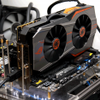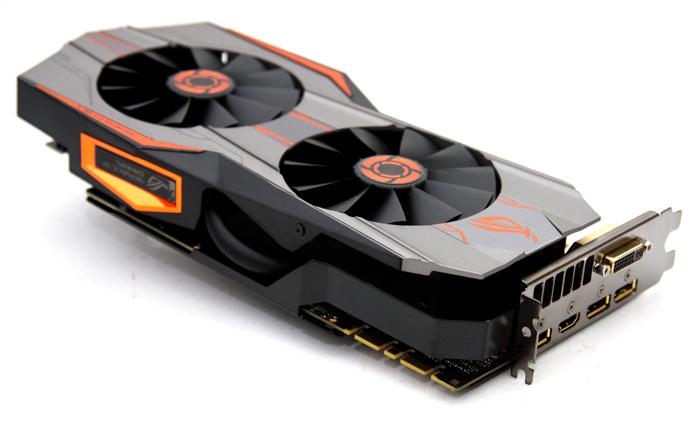Conclusion
Conclusion
The Asus GTX 980 Ti Matrix Platinum edition is a cool dude, literally -- but despite all that PCB redesigning, extra power phases and Lamborghini-like features, it will tweak just as good as the competition. If anything, all previous reviews have already shown that all GTX 980 Ti cards end roughly at a Dynamic Boost frequency of 1500 MHz. It's not the fault of ASUS or for that matter any brand, it's Nvidia who in the last 2 years added more and more limiters. Once the cards pass a certain power signature, voltages go down automatically combined with the dynamics clocks. Then there are power limiters, voltage limiters, clock limiters, thermal limiters, heck, even SLI limiters. That combined with ASIC quality is slowly becoming a frustrating sight not just for the end-users, but for ASUS just as well. I mean this is their absolute best and while there surely will be some exceptions on overclocking the generic rule is simple, all air based cards do roughly 1.5 GHz max. The sheer design that is the Matrix GTX 980 Ti is of course exquisite. The card is build majestically and has looks to kill (I really should throw in some James Bond puns this week eh?). The card offers an excellent Spectreum in thermals, under very heavy gaming you'll be at the 60 to 65 Degrees C marker. That does however come at the cost of a triple slot wide graphics card design. Another benefit however is the that the product is VERY silent. Performance then, the Matrix simply beats the Titan X with a good margin, and then slaps it around a bit more. Armed with 6GB of graphics memory and combined with the sheer rendering muscle this card has, you'll be future proof for a while. The one question that remains, and I will address this in each and every 980 Ti review, is simple; do you really need a card as beefy as the GTX 980 Ti really is? Well no Sir, not at all if you are playing games in the 1080P or 2560x1440 monitor resolution domain as the GTX 970 or 980 is sufficient. Then there is Ultra HD, that brute resolution of 3840x2160 requires sheer raw horsepower to output its 4x Full HD resolution, and the GTX 980 Ti is one of few cards that can handle this resolution well with very decent image quality settings. So again, value for money wise you are way better off with a card like the GeForce GTX 970 or 980, make no mistake about that as there is no doubt. But this is enthusiast grade graphics hardware, and yeah it kinda rules. Plus you are a little more future proof with the nice 6GB frame-buffer of course.
Aesthetics
So, the ASUS GeForce GTX 980 Ti Matrix is a terrific looking product in my opinion. It comes with a lovely PCB design, good overall looks with the two fans / three slot design, the shielding and the PCB is just lovely in its matte black and ultra-clean design. So yes, overall it is a good looking product with a dark matte PCB and grey/black orange cooler accents. A nice addition is the LED lit logo, when the GPU load is in idle it is colored green, upwards (depending on GPU load levels) it'll go RED. Overall it is an aesthetically pleasing product. Looks however are personal, that I have to mention.
InSPECTRE Gadget
The reference design of the GTX 980 Ti is set at an offset threshold of 80 degrees C. Once the GPU gets warmer the card will clock down and lower its voltage. ASUS uses a DirectCU II based cooler that manages roughly 600W of cooling performance. The card runs close to 63 degrees C under stressed conditions, the cooler however can perform better, but at the cost of slightly more noise. Set the cooler at a fixed 45% and your temps will drop under 60 Degrees C. The decision ASUS made here was a logical one, less noise. Please do note that you will ALWAYS need proper ventilation inside your chassis to achieve that number. Also keep in mind that 63 Degrees C is excellent considering this product is overclocked pretty sweet for you already. At default settings you may expect sound pressure values in the 39 dBA range at max under load. That's measured 75 CM away from the PC. This means the card is working in a silent to normal dBA range. As stated, the downside is the slightly higher temps, but really they remain fine, especially when you take the factory overclock into consideration eh? We have not heard any coil whine noises.
Power Consumption
The reference GTX 980 Ti is rated as having a 250~260 Watt TDP, our measurements pass that number by a good degree as we measured roughly 300 Watts. It is likely due to the factory overclock, which we assume requires additional voltage inside that GPU. We remain comfortable advising a 650 Watt power supply for your PC with one card installed, if you do not go crazy overclocking wise. If you go with 2-way SLI, something like a 950 Watt power supply is recommended. Here again keep in mind we measure peak power consumption, the average power consumption is a good notch lower depending on GPU utilization. Also, if you plan to overclock the CPU/memory and/or GPU with added voltage, please do purchase a power supply with enough reserve. People often underestimate it, but if you tweak all three aforementioned variables, you can easily add 200 Watts to your peak power consumption budget. Remember when purchasing a PSU try to calculate what your PC will be using power wise in Wattage, then double up that Wattage as your PSU is most efficient when it is under 50% load.
Game Performance
We can't be any clearer about it, all ranges from 1080P to Ultra HD are very playable for the GeForce GTX 980 Ti. Up-to WQHD (2560x1440) this card seems to be at a true sweet-spot, however it is really capable of rendering games in that whopper of a resolution Ultra HD as well. You'll be in the 40 FPS on average domain with decent settings and the latest titles mostly, and that's ok. This much game rendering horse-power versus the nice 6GB graphics memory helps you in Ultra HD, hefty complex anti-aliasing modes, DSR and of course the latest gaming titles. And that makes this the second viable single GPU solution that allows you to game properly in Ultra HD with some very nice eye candy enabled with a single GPU. Drivers wise we can't complain at all, we did not stumble into any issues. And with a single GPU there's no micro-stuttering to fight off. Performance wise, really there's not one game that won't run seriously well at the very best image quality settings. You must do gaming with a nice 30" monitor of course, at 2560x1440/1600 or Ultra HD.
Overclocking
The boost modes can be configured with temperature targets relative to maximum power draw and your GPU core frequency offsets. Saying that; I realize it sounds complicated but you'll have your things balanced out quite fast as these products are easy to tweak. Our GPU sample could take a 1270~1290 MHz base clock, add to that the dynamic boost clock and you'll see your games rendering in the 1450 to 1500 MHz domain. The memory you'll be able to get just over 8 GHz effective. This card uses Hynix memory btw. Don't push memory too far though. The overclock potential is good, albeit it has a fantastic factory clock frequency as default already, of course.
Concluding
ASUS offers a truly terrific graphics card with the all new Matrix. Their flagship product oozes style and quality design. It however impresses just as much as the competition when it comes to raw performance. All factory tweaked SKUs perform roughly in the same range. For regular end-uses the direct benefits are to be found in overall design and excellent cooling levels. The board however offers more potential for the fifteen LN2 overclockers worldwide who will voltage mod these cards. These guys will get proper overclocks and benefit from defrost features and what not. But considering we write for the generic audience... the benefits of this great card end at excellent performance, normal tweaking and overclocking levels, a great design, good looks, nice low noise cooling and a nice factory overclock. Overall though it's a good product if you look at it from a pure performance perspective, it has a very fast out of the box factory clock frequency. The PCB is 100% custom, the GPU is kept at very acceptable temperatures, the components on-board remain at decent temperatures, the looks are good, the board design is sturdy with metal plates, and even the backside is covered by a back plate. The performance is seriously faster than a GTX Titan X, yet pricing is much better at a price of roughly $750 USD/EURO. In the end this product will offer you a AAA gaming experience in any monitor resolution, as even Ultra HD now becomes a viable resolution for single GPU setups. The card does so while keeping itself at nice temperatures. Compared to the GeForce GTX 980 Ti at 2560x1440 you can expect an increase of up-to say 25% performance (over the reference GeForce GTX 980 Ti) and overclocked you can add another 10%. So what would I recommend to you... the ASUS GeForce GTX 980 Ti STRIX or this Matrix? Well, price wise the STRIX makes a lot more sense, the Matrix cooling levels however are superior. Tweaking wise you'll end up roughly at the same levels. So yeah, cooling, aesthetic preferences and your budget should be the decisive factor for you. Despite the 'normal' maximum tweak potential we do think this product comes highly recommended to those who do not like overclocking themselves and want a spectacular looking product inside their PC. It, as such, is a top pick.
Recommended Downloads
- Sign up to receive a notice when we publish a new article
- Or go back to Guru3D's front page



